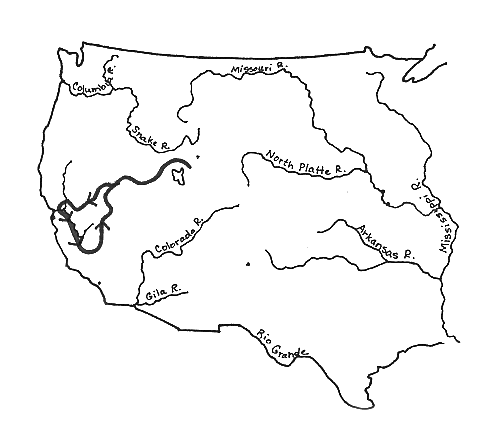| ||||
|
| ||||
|
JOSEPH
R. WALKER
 Lived:
1798-1876
Lived:
1798-1876
Explored California in: 1833-1846
Exploring for: United States
Explored: by land throughout California
American interest in Mexican California increased in the 1830s as fur trappers and traders reported on the green valleys and rivers with their wildlife, and the pleasant climate. The American government was interested in gathering more information about California and its Mexican officials.
EARLY HISTORY
Joseph Reddeford Walker was born in 1798 in Tennessee, still considered the western frontier at that time. There he grew up learning the skills of the wilderness. He moved to Missouri when he was a young man, and in 1820 joined a party of trappers heading for the Rocky Mountains and New Mexico. In 1824-25 Walker was the guide for a survey party marking parts of the Santa Fe Trail. He served as sheriff of Jackson County, Missouri, from 1827 to 1830.
BACKGROUND
It was in 1831, while Walker was on a trading expedition west of Missouri, that he met Captain Benjamin Louis Eulalie de Bonneville, a French-born officer of the 7th U.S. Infantry. Soon after that, Captain Bonneville asked for a leave from the Army in order to make a fur trapping trip into the Far West. Some sources say that it was Walker who convinced Bonneville that he could make a lot of money trapping furs. It may be that Bonneville’s interest was actually more in gathering military information about the Mexican government in California.
Bonneville and a group of 110 trappers started west in 1832. Joseph Walker was with them as a guide and scout. They were the first group to take wagons through the South Pass of the Rocky Mountains. This pass had been explored in 1824 by Jedediah Smith. Many pioneers followed Bonneville’s lead and used this route in the 1840s and 1850s to go west to Oregon and California.
After meeting with other fur trapping companies at a rendezvous near Great Salt Lake in the summer of 1833, Bonneville divided his party. He sent a detachment led by Joseph Walker to follow the Green River south in Utah and continue on across the Great Basin to California.
WALKER’S JOURNEY
Walker and his men left the rendezvous at Great Salt Lake and made their way across the Great Basin of western Utah and Nevada. They followed the Humboldt River (then called Mary River) southwest across Nevada to Carson Lake.
They then headed into the eastern slopes of the Sierra Nevada Mountains. Their mountain crossing was a difficult one, taking 23 days. They lost many of their pack animals in the mountains. At one point, after passing the summit, they wandered for several days, confused by the maze of lakes and mountains peaks.
The trail they blazed led them through what is now Mono, Mariposa, and Tuolumne counties. They were the first white men to record seeing Sequoia gigantea, the Giant Sequoia trees. They were also the first to record a visit to Yosemite Valley. With Walker was Zenas Leonard, a clerk who kept a detailed diary of the expedition. He described “many small streams which would … precipitate themselves from one lofty precipice to another.… Some of these precipices appear to be more than a mile high.”
From Yosemite Valley, Walker’s group followed the Merced River to the San Joaquin, trapping beaver as they went. When they reached the peninsula on the west side of San Francisco Bay, they camped there.
Anchored offshore near their camp was an American ship. The sailors came onto the beach, and the two groups had a party that night. It was the first time that Americans who had crossed the Sierra Nevada into California met with Americans who had come by sea.
In Monterey, Mexican Governor José Figueroa gave Walker permission to trap in California. This was a friendlier welcome than other trappers had received from the previous governor, José Echeandía. Walker stayed in Monterey for several weeks before heading back into the San Joaquin Valley.
The company trapped beaver as they made their way south through the valley. They left California in 1834 through a pass in the Tehachapi Mountains which is now known as Walker Pass. Nine years later, Walker used this route again when he guided the Joseph. B. Chiles party of emigrants from Fort Laramie to California in 1843. This was the second wagon train to enter California from the east.
In 1845 Joseph Walker was the guide for John C. Frémont on his second expedition into California. Frémont sent Walker and the main part of his group through Walker Pass, while Fremont himself used Donner Pass to cross the Sierra Nevada.
WHAT HE ACCOMPLISHED
Both Walker’s crossing of the Sierra Nevada from east to west near Yosemite in 1833, and his opening of Walker Pass in the Tehachapi Mountains to the south in 1834, were important to the stream of settlers who soon began coming to California. Walker’s name is remembered not only by Walker Pass, which is now a National Historic Landmark, but also by Walker Lake in Nevada.
LATER YEARS
Walker raised cattle in Monterey County from 1851 to 1858. He then worked with Kit Carson as a guide on the Colorado River. In 1861 he went to New Mexico and Arizona to prospect for gold. Walker’s nephew, James T. Walker, had acquired some rancho land in Contra Costa County in the 1850s. In 1868 he built a home on the property, which is between present-day Walnut Creek and Mount Diablo State Park. Joseph Walker went to live there with his nephew, where he died in 1876 at the age of 77.